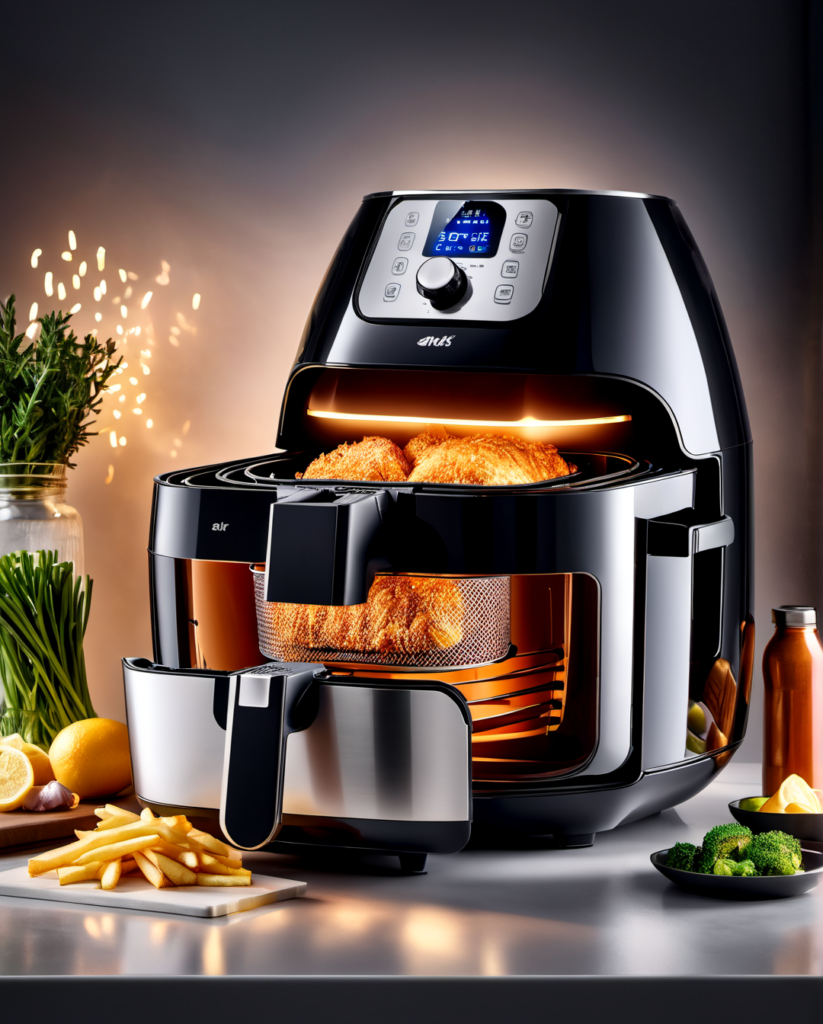When examining the science behind air fryers, it’s clear these popular appliances utilize more than just hot air. Built upon principles of thermodynamics, rapidly circulating heat at optimal velocities allows for quicker moisture evaporation off food surfaces compared to traditional ovens. This concentration of convective energy at ideal airflows enables crispier exteriors containing less oil to develop through Maillard reactions. The science behind air fryers essentially harnesses heat transfer optimization tailored to mimic deep frying results without the grease.
The Magic of Hot Air
At the heart of every air fryer is a powerful convection fan and a heating element. The science begins with the circulation of hot air at high speeds, creating a miniature tornado within the cooking chamber. This innovative technique replaces traditional deep frying by enveloping food in a whirlwind of hot air, resulting in a coveted crispy texture without excessive oil.
Maillard Reaction: Science Behind Air Fryers
As the hot air dances around your favorite ingredients, it initiates a culinary ballet called the Maillard reaction. This complex chemical process is responsible for the golden brown color and rich flavors of various foods during cooking. The air fryer, with its precision-controlled environment, enhances the Maillard reaction, ensuring a perfect balance of crispiness and flavor in every bite.
The Art of Moisture Management
The science behind air fryers relies on meticulous moisture management through calculated thermodynamic principles. The appliance’s swiftly circulating hot air behaves like a moisture-wicking force, continually evaporating liquid from an ingredient’s exterior surfaces. This intense convective heat transfer leaves less time for moisture to redistribute inward, enabling beautifully crispy, crunchy exteriors to develop without the sacrifice of inner juiciness and tenderness that traditional frying often fails to prevent. It’s a delicate balance of chemistry, physics, and food science—harnessing airflow, temperature, and time variables to achieve textures previously unattainable for oil-free cooking.
Bursting the Myth of Uniformity
Contrary to the misconception that air-fried dishes are monotonously uniform, the science behind the appliance allows for a symphony of textures. The burstiness in an air fryer-cooked meal comes from the versatility of the machine to handle a variety of ingredients. From crispy kale chips to succulent chicken wings, the air fryer accommodates a spectrum of textures and flavors, mirroring the diverse nature of human culinary expression.

Beyond Convenience: Health Benefits Unveiled
Apart from the textural marvels, the air fryer has positioned itself as a health-conscious kitchen companion. By significantly reducing the need for excessive oil, it offers a guilt-free alternative to traditional frying methods. The science behind air fryers uses precise heat and airflow to mimic deep frying, delivering all the crispy enjoyment without the oil and guilt.
Science Behind Air Fryers: The Future of Culinary Exploration
Air fryers represent an innovation transforming home cooking by leveraging science. These appliances harness rapid air circulation technology to replicate deep frying with less oil, unlocking a new world of culinary potential. Though a seemingly simple kitchen gadget, the air fryer enables the artistry and versatility once solely possible for professional chefs. As convection heat crisps and caramelizes with precision, the possibilities stretch from fried chicken to crème brûlée.
Air fryers herald a movement towards more advanced yet accessible ways of cooking, blending scientific principles with creative exploration. This technology signifies a promising future for amateur cooks and seasoned gourmands seeking to reinvent their favorite dishes.
How does an air fryer work to cook food with less oil?
Air fryers use a high-powered fan to circulate hot air around the food at high velocity, creating a convection environment that replicates deep frying. The rapidly moving hot air cooks the food and evaporates moisture quickly to produce a crispy exterior while using little to no oil.
What is the Maillard reaction and how does it relate to air frying?
The Maillard reaction is the chemical process that produces the desirable golden-brown color and rich, complex flavors when cooking. The precise temperature and airflow control in an air fryer optimizes the Maillard reaction to deliver exceptional flavors and aromas with less oil.
How does an air fryer maintain juicy interiors when cooking?
The intense convection heat of an air fryer evaporates moisture rapidly from the outer surface of the food. This creates a crisp exterior while allowing less time for moisture to redistribute inward, helping retain tender and juicy interiors.
Can you get a variety of textures using an air fryer?
Yes, air fryers can accommodate a wide range of ingredients and achieve diverse textures from crispy kale chips to juicy meats. The precision temperature and timing controls allow cooking items perfectly whether you seek crunchiness or tenderness.
What are the health benefits of using an air fryer?
Air fryers significantly reduce the amount of oil needed for cooking, lowering overall fat and calorie intake. This makes them an excellent option for healthier cooking and weight management compared to traditional deep frying.



Pingback: How To Use Air Fryers :Guides and Tips | Everything About Air Fryers
Pingback: The 12 Air Fryer Myths | Everything About Air Fryers
Pingback: Alluring Air Fryer Tofu Nuggets - Everything About Air Fryers
Pingback: Delicious Air Fryer Chicken Sausage - Everything About Air Fryers
Pingback: The 12 Air Fryer Myths - Everything About Air Fryers
Pingback: How To Use Air Fryers :Guides and Tips - Everything About Air Fryers
I don’t think the title of your article matches the content lol. Just kidding, mainly because I had some doubts after reading the article.